Brighten your day with this light and airy Meyer Lemon Chiffon Cake that‘s bursting with a sweet citrus smell. Reminiscent of my favorite Japanese yuzu, Meyer lemons have an incredibly refreshing fragrance and tart sweetness that‘s perfect for desserts. Top this delicate Japanese cake with powdered sugar or my Meyer Lemon Icing Glaze.
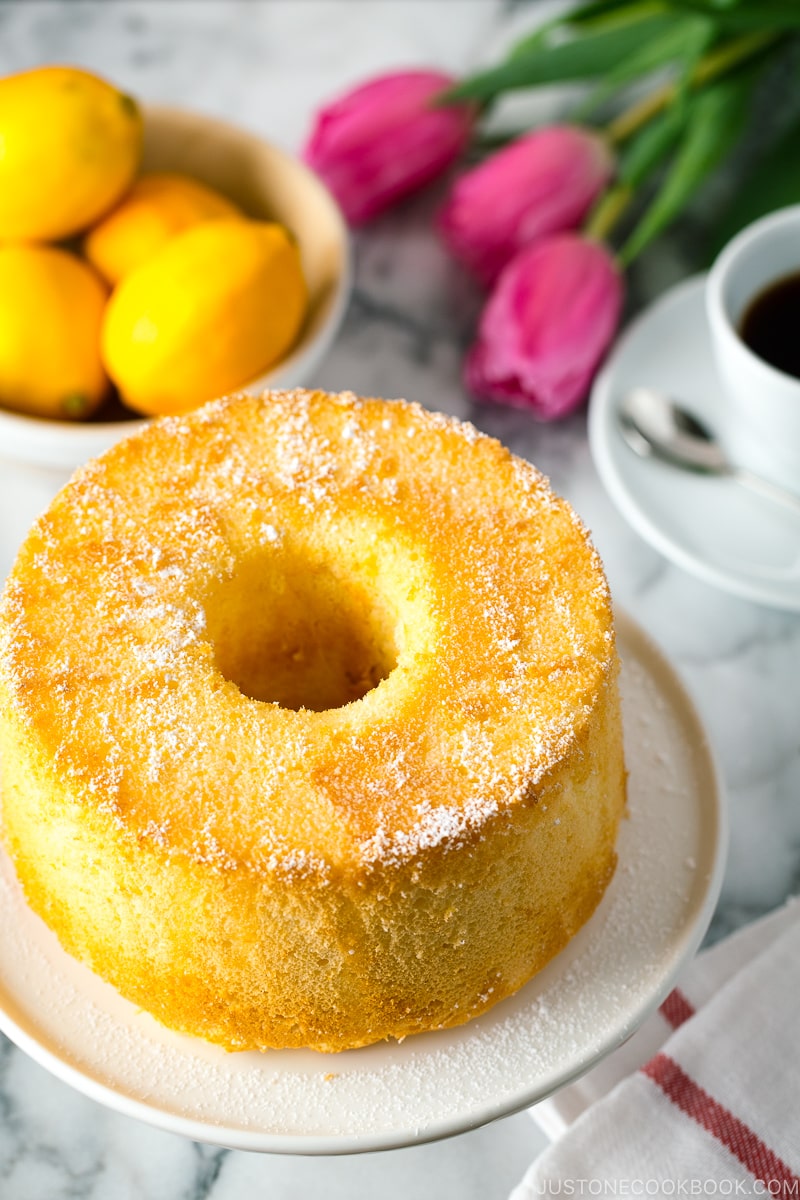
Bright, sweet, and tart. Citrus fruits are the sunshine of the cold season. Right here in California, I am so grateful to find fresh Meyer lemons at my local farmers market from the start of November all the way through May. Said to be a cross between a lemon and a mandarin orange, Meyer Lemons remind me of my favorite Japanese Yuzu. Both citrus fruits have an incredibly refreshing aroma and fragrance that they are best used in dressings and desserts.
Whenever I scoop up some of these seasonal fruits, I can’t wait to make this Meyer Lemon Chiffon Cake. A light, airy cake that is bursting with the sweet scent of lemons. It’s a perfect slice of cake to enjoy with coffee or tea!
What is Meyer Lemon?
Some of you may not have heard of Meyer lemons. I didn’t know anything about it until I came to the United States. When I Googled Meyer lemon, I found out they originated in China (that was unexpected) and were brought to the U.S. by Frank Meyer – which explains the name.
But Meyers lemons didn’t become popular until the end of the 1990s when chefs like Alice Waters at Chez Panisse started to use in “California Cuisine” and Martha Stewart featured them in her recipes (source).
Meyer lemons are moderately acidic and do not have the tangy flavor of regular lemons. They even taste slightly sweet. My favorite part of Meyer lemons is their rinds. They smell so good that if there were a pile of Meyer lemon zest I feel like I could dive right in!
Another Meyer lemon recipe: Meyer Lemon Pound Cake
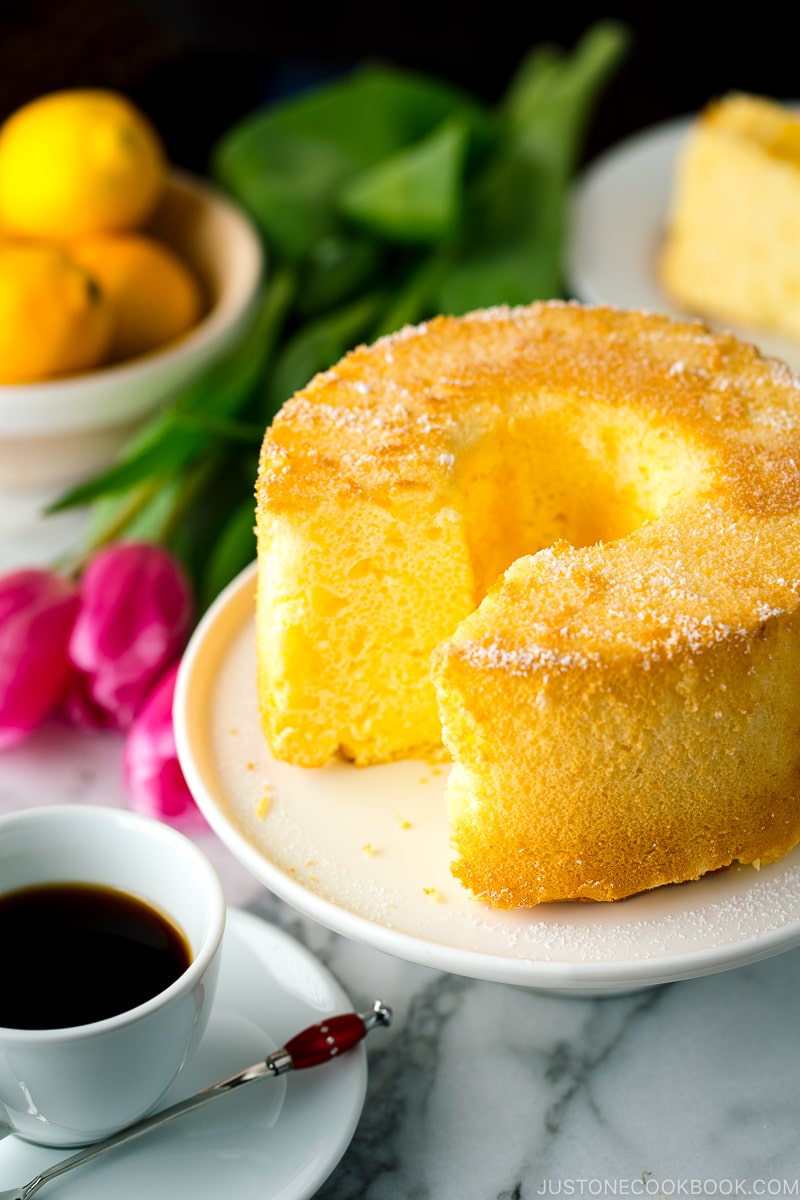
Airy, Fluffy, Not-So-Sweet Meyer Lemon Chiffon Cake
Chiffon cake has been one of my favorite desserts to make at home. Once you learn the trick of making a delicate, frothy meringue, the rest of it is rather straightforward.
Popular Dessert Cake In Japan
The Japanese love a good cake! As the texture is light and airy, chiffon cakes are a popular dessert cake in Japan. They are made of simple ingredients like oil, eggs, sugar, flour, and flavorings. Personally, I enjoy making chiffon cakes at home because I can balance the taste with a key flavor so it’s not overly sweet. With their intense and natural sweetness, Meyer lemons make an excellent flavoring for the cake.
Can we substitute regular lemons for Meyer Lemons?
Yes, you can, in most recipes. Just keep in mind that the Meyer lemon is less tart and slightly sweeter. You probably want to increase the amount of sugar a tiny bit and use less juice. I haven’t tested this chiffon cake recipe with regular lemons. If I tried it one day, I’ll write down the measurement in the recipe (please remind me).
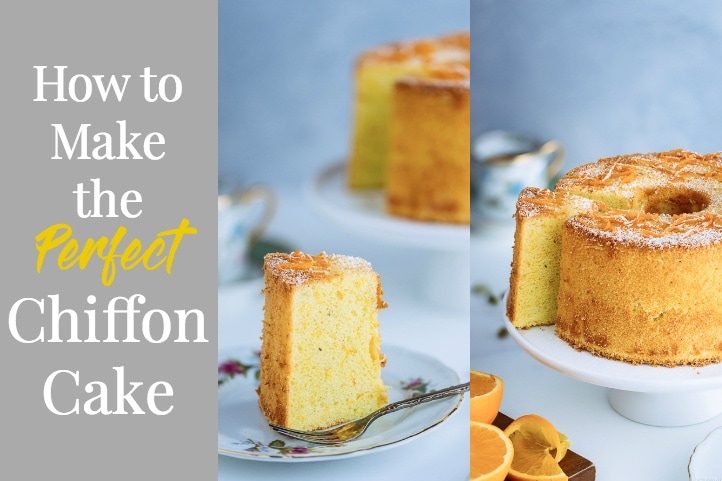
How to Make The Perfect Chiffon Cake
If you are a beginner baker and wish to give this chiffon cake a try, you will want to master the technique of whisking the meringue (beaten egg whites). Just like any baking project, it takes some practice, but the result is always rewarding.
I have a comprehensive guide on How to Make The Perfect Chiffon Cake for your reference. You’ll find everything you need to know, including the right baking pan, troubleshooting, and FAQs. Have a read before you start.
And while the citrus fruit is still in season, I hope you grab a bag and make this delightful Meyer Lemon Chiffon Cake!
More Amazing Dessert Cake Recipes You’ll Love:
- Matcha Green Tea Chiffon Cake
- Earl Grey Chiffon Cake
- Orange Chiffon Cake
- Chocolate Chiffon Cake
- Matcha Mille Crepe Cake
- Castella Cake (Easy Japanese Honey Sponge Cake)
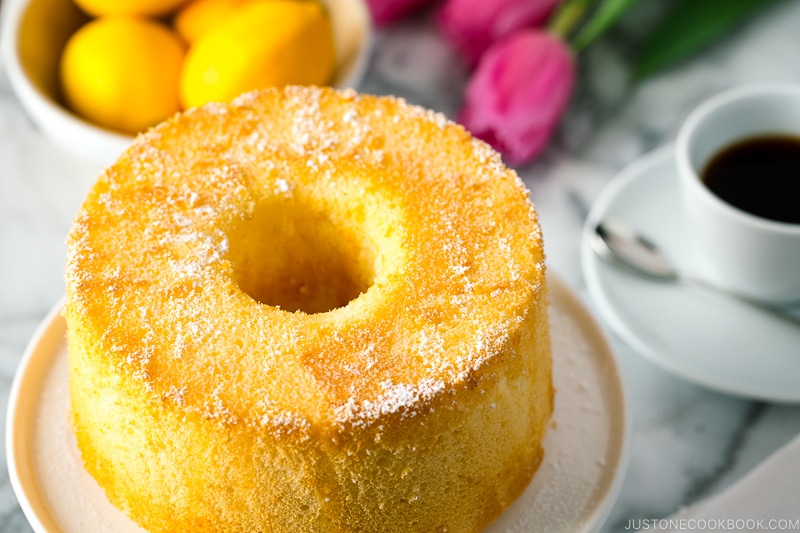
Wish to learn more about Japanese cooking? Sign up for our free newsletter to receive cooking tips & recipe updates! And stay in touch with me on Facebook, Pinterest, YouTube, and Instagram.
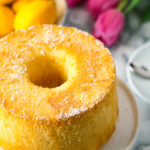
Meyer Lemon Chiffon Cake
Video
Ingredients
- 3 large eggs (50 g each w/o shell) (yolks and whites separated)
- 85 g sugar (½ cup minus 1 Tbsp; divided into thirds)
- 40 ml neutral oil (3 Tbsp minus 1 tsp)
- 2 Meyer lemons (for the zest and ¼ cup (60 ml) of juice)
- 75 g cake flour (⅔ cup minus 2 tsp; weigh your flour or use the “fluff and sprinkle“ method and level it off; you can make Homemade Cake Flour)
- 1 tsp baking powder
For Serving
- 2 Tbsp confectioners’ sugar (for dusting on the cake; optional)
For the Meyer Lemon Icing Glaze (optional)
- ½ cup confectioners’ sugar
- ½ Meyer lemon (for 1 Tbsp juice)
Instructions
Before You Start…
- Gather all the ingredients. I highly encourage you to use metric measurements using a kitchen scale for this recipe. Click on the “Metric“ button at the top of the recipe to convert the ingredient measurements to metric. If you‘re using a cup measurement, please follow the “fluff and sprinkle“ method: Fluff your flour with a spoon, sprinkle the flour into your measuring cup, and level it off. Otherwise, you may scoop more flour than you need.
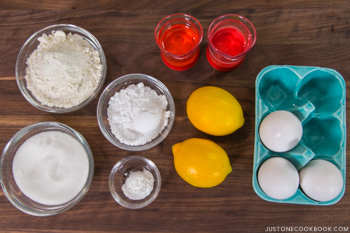
- You will also need a 17-cm (7-inch) chiffon cake pan. If you have a different size pan, learn how to adjust the ingredient measurements in my post How to Make the Perfect Chiffon Cake. Make sure you use an aluminum pan with a removable base (read my blog post for more details). Please see my Notes at the end of this recipe for additional details on ingredients, equipment, and techniques.
To Mix the Batter
- Preheat the oven to 340ºF (170ºC). For a convection oven, reduce cooking temperature by 25ºF (15ºC). Separate the egg yolks and egg whites of 3 large eggs (50 g each w/o shell), and keep the whites in a small bowl or a stand mixer bowl. Refrigerate or freeze the mixer bowl and the egg whites for 15 minutes until cold. (It‘s okay if the egg whites are partially frozen). Tip: In Japan, we chill the egg whites to make smooth, fine-textured meringue and do not use cream of tartar.
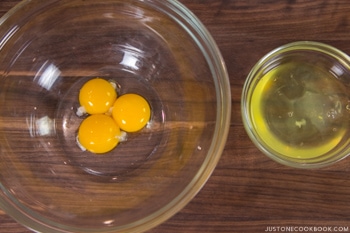
- Start mixing the batter. In a large bowl, beat the egg yolks and one-third of the 85 g sugar (½ cup minus 1 Tbsp) with a hand whisk. Whisk vigorously until it‘s a creamy, pale yellow color.
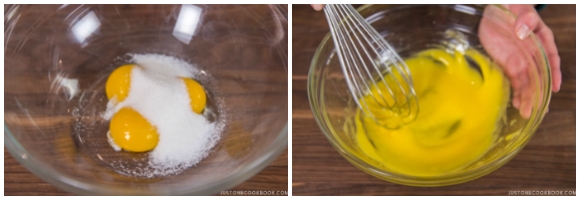
- Next, add 40 ml neutral oil (3 Tbsp minus 1 tsp) and the zest of up to 2 Meyer lemons. Tip: I love the intense fragrance and sweetness of Meyer lemons, so I use the zest of 2 lemons. You can use 1, if you‘d prefer.
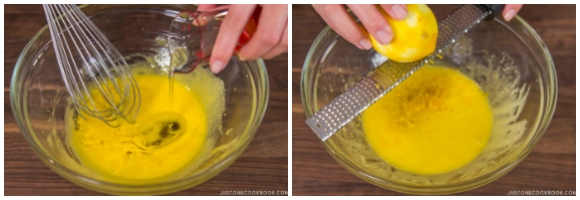
- Cut the Meyer lemons in half. Juice all 4 halves into a measuring cup.
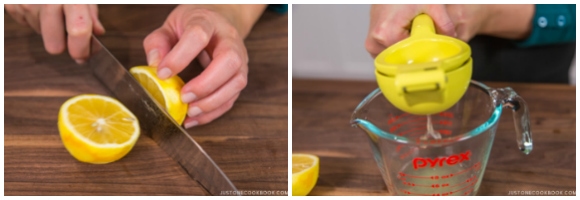
- Measure 4 Tbsp (¼ cup or 60 ml) lemon juice. If you don‘t have enough juice, add water to make up the difference.
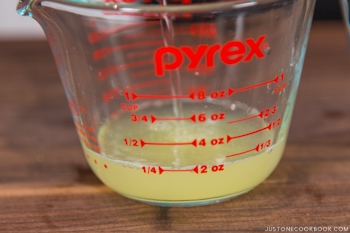
- Add the lemon juice to the egg mixture and whisk well.
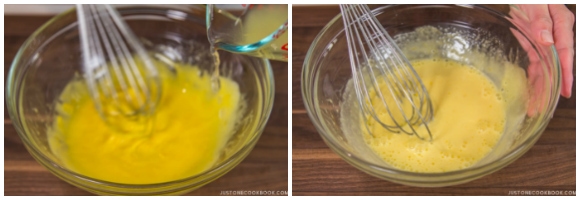
- To a flour sifter or fine-mesh sieve, add 75 g cake flour (⅔ cup minus 2 tsp) and 1 tsp baking powder. Sift one-third of this flour mixture into the egg yolk mixture. Whisk by hand to incorporate the dry ingredients well. Check that there are no lumps in the batter, then sift another one-third of the flour mixture into the bowl. Mix to incorporate. Then, sift in the rest of the flour mixture and whisk until just combined; do not overmix. Make sure there are no lumps in the batter. Set aside while you beat the meringue.
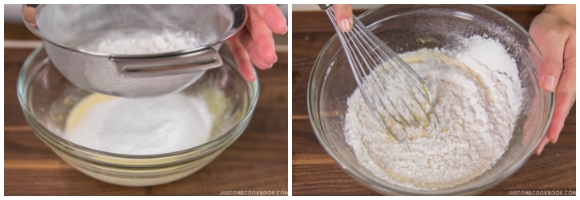
To Make the Meringue
- Take out the egg whites and the mixing bowl from the refrigerator or freezer. Set the bowl on the stand mixer with a whisk attachment (I used the KitchenAid Professional Series). Start whipping the egg whites on medium-low speed (Speed 4) until the egg whites are bubbly, opaque, and foamy. Add another one-third of the remaining sugar and continue whisking.
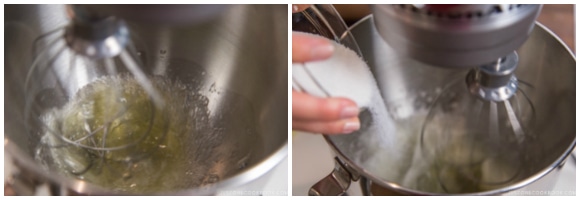
- After 30 seconds or so, increase the mixer speed to high (Speed 10) and gradually add the remaining sugar in small increments. Beat vigorously until stiff peaks form (see the next step for how to check). It takes about 2 minutes of beating at high speed to reach stiff peaks. Tip: I usually pause beating when the egg whites are almost done. Take off the whisk attachment from the mixer and use it to hand-mix the looser egg whites near the bowl‘s edge into the stiffer whites near the center until it‘s homogeneous in texture. Then, put the whisk back on and continue beating.
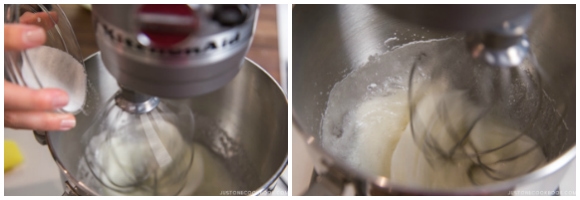
- To check for stiff peaks, pull up your whisk. The meringue in the bowl or on the whisk should be firm enough to hold a peak, pointing straight up (or maybe folding over a little bit just at the very tips). By this time, the meringue should have a glossy texture, too. Tip: If you overbeat the meringue, it will become very stiff and grainy and won't incorporate into the batter at all.
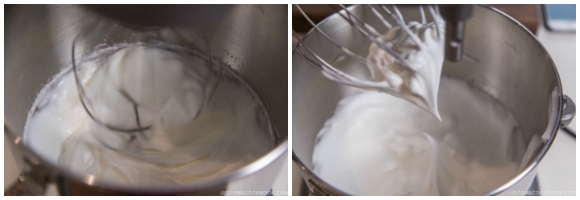
To Fold In the Meringue
- Using a spatula or hand whisk, add one-third of the meringue into the batter. Mix well by hand until it‘s homogeneous.
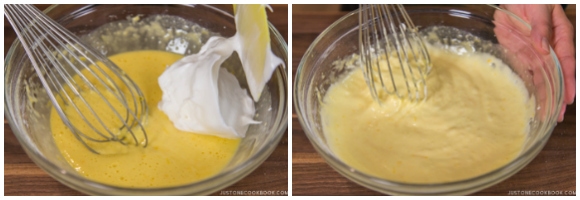
- Gently fold in the rest of the meringue in 2 or 3 increments. Take care not to deflate the air bubbles in the meringue and batter as you fold. Once it‘s well combined and homogeneous, fold the batter one last time and scrape the sides and bottom of the bowl to make sure there is no zest accumulation. The final batter should fall in ribbons when you lift the spatula or whisk.
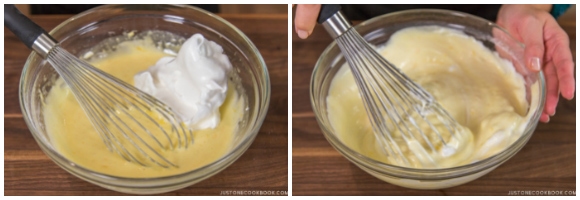
To Bake
- Prepare an ungreased 17-cm (7-inch) chiffon cake pan. From 6–8 inches high, pour the batter into the pan at just one spot to prevent air pockets from forming.
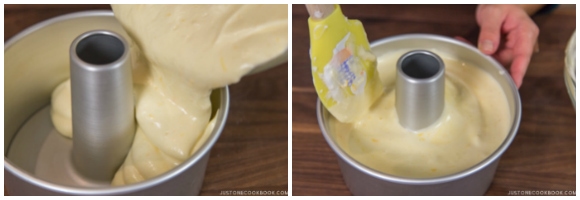
- Run a wooden skewer through the batter to release any remaining air pockets. While holding the removable base in place, gently tap the pan a few times on the work surface to release any air pockets in the batter.
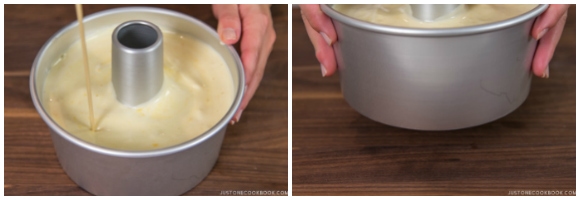
- Put the cake pan on the middle rack of the preheated oven. Bake at 340ºF (170ºC) for 30 minutes. To check if it‘s finished baking, insert a toothpick or wooden skewer into the middle of the cake. If it comes out clean and the top of the cake springs back when gently pressed, it‘s done. Tip: If the top of the cake gets dark too quickly, cover the top loosely with aluminum foil to prevent burning. (The cake may be too close to the heat source.)
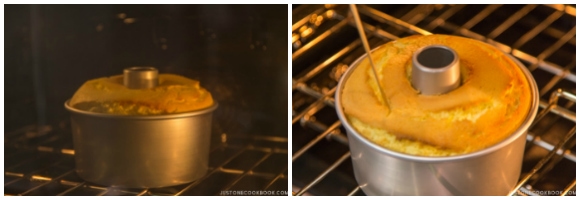
- Remove the cake pan from the oven and gently drop the pan onto the work surface to shock the cake. This stops the cake from shrinking. To cool the cake, prepare a tall, heavy bottle with a long neck, such as a glass wine bottle. Invert the center tube of the cake pan onto the bottle‘s neck and let the cake cool completely in its pan. Cooling the cake upside down helps it stretch downward and maintain its loft.
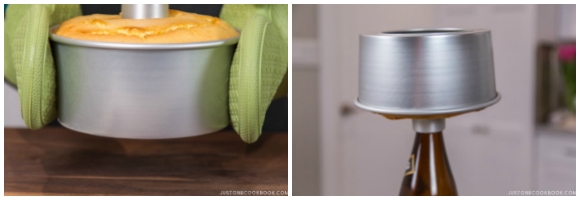
- Once the cake is completely cool, run a long offset spatula around the outer edge of the pan and a small offset spatula around the inner tube. Tip: I used to use a knife for this step, but the tip of the knife tends to poke the cake while moving around, so I now recommend using offset spatulas.
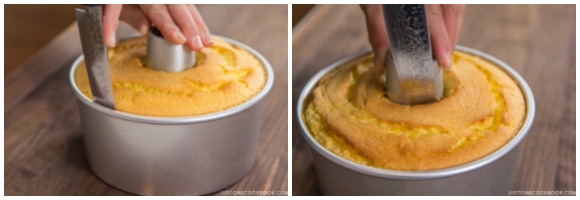
- Gently take out the removable base and cake from the outer pan. Then, run the offset spatula along the bottom of the cake to release it from the base. Invert the cake with the removable base onto a plate or cake stand. The cake will slide off the inner tube. Chiffon cake is served “upside down” with the flat bottom on top.
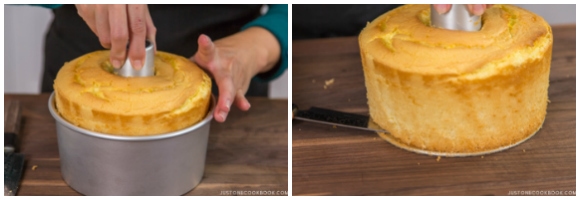
To Serve
- Dust the top of the cake with 2 Tbsp confectioners’ sugar (optional), if you‘d like. Alternatively, you can top the cake with Meyer Lemon Icing Glaze (optional). To make the glaze, place ½ cup confectioners’ sugar in a small bowl and stir in the juice of ½ Meyer lemon. The glaze should be thick, but pourable. Add more sugar or Meyer lemon juice as necessary to achieve the desired consistency. Drizzle over the cake using a spoon. Slice and enjoy!
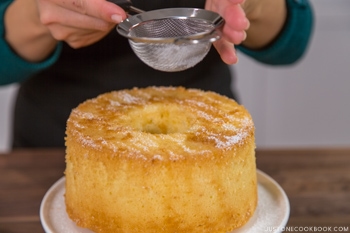
To Store
- I strongly recommend consuming the cake sooner for the best freshness. However, you can keep the cake covered on a plate or stand at room temperature in a cooler place for 1–2 days. To keep it longer, wrap individual slices in plastic wrap or put in an airtight container and store in the refrigerator for 3 days or in the freezer for 2 weeks.
Notes
- Make sure your beaters and mixing bowl are clean and dry. A speck of oil or egg yolk on either one can minimize the volume of the beaten egg whites.
- Avoid plastic bowls, as even clean ones may hold oily residue that can affect the beaten quality of the egg whites.
- Use a bowl that’s wide enough to keep the beaters from being buried in the egg whites.
- Do not overbeat or underbeat the egg whites or your cake may fall. Egg whites should have a stiff peak, pointing straight up (or maybe a little bit folding over just at the very tips).
Nutrition
Editor’s Note: The post was originally published on Mar 2, 2016. It has been edited and republished in February 2020.
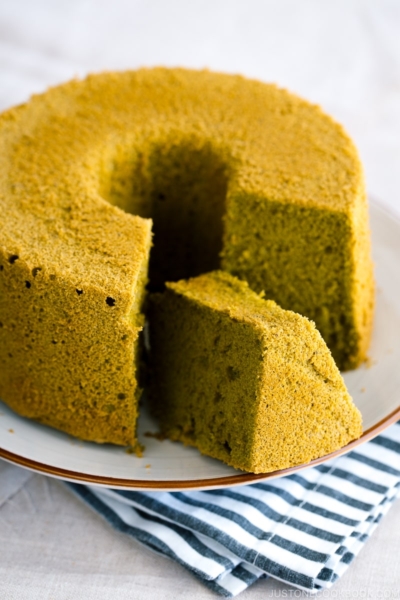
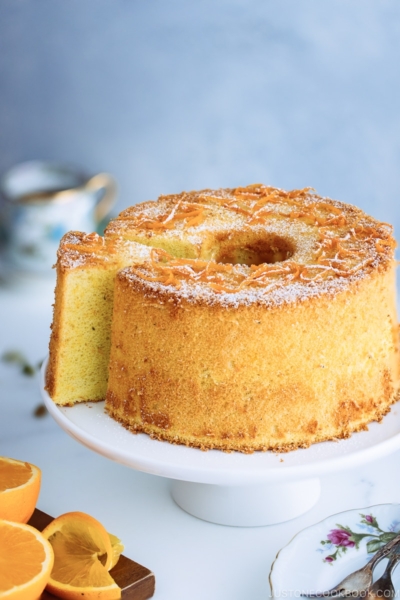
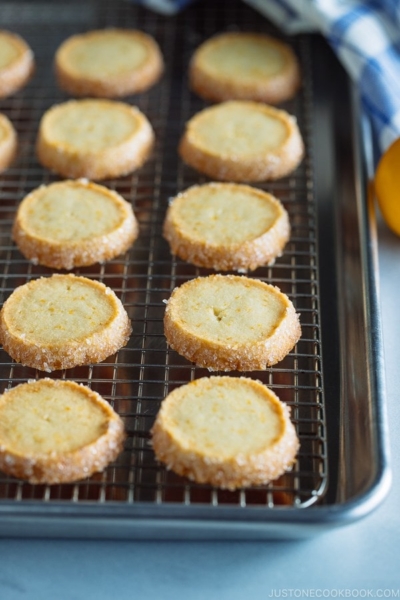
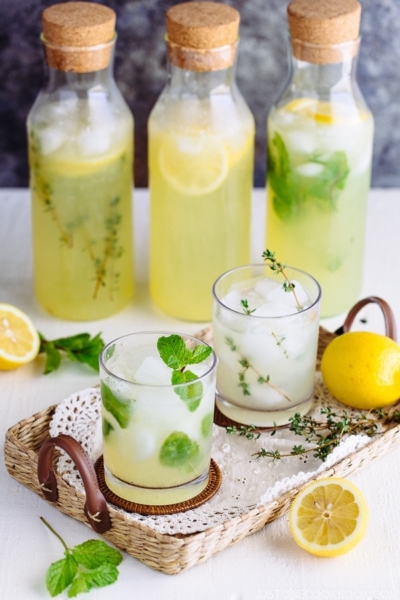





I was finally able to find meyer lemons, so made the only JOC chiffon cake I hadn’t tried yet! I did try making it previously with regular lemons and clementine orange (approx. 2/3 & 1/3 ratio), but didn’t want to post until I found real meyer lemons. I didn’t see any at all last year no matter where I looked, then happened to find a giant bag at Costco, haha. You can see the difference with regular lemons (on the right of picture).
For this cake pictured, I used the JOC 2 egg / 15cm and baked in Asai Shoten “tall” 14cm chiffon cake pan. I also used the Asai Shoten cake cooler I got when I went to Japan in Fall 2024. It was nice to go shopping at 浅井商店 in person!
Hi T J! Wow! What a lovely chiffon cake!🤩
Thank you for experimenting with both lemons and sharing the photo. This is very helpful.🥰
Thank you so much for your love and support! Happy baking!
Followed your recipe and it turned out beautiful.. very tart and lovely.
Hello Joanna! Aww.😍 Thank you very much for trying Nami’s recipe and sharing your cake photo with us!
It looks perfect! 👏🏻
I would like to double the recipe and use a 10 inch tube cake pan. Is it simply a matter of doubling all the ingredients?
Hello, Annie. Thank you for trying Nami’s recipe.
Doubling all of the ingredients will fit in your pan, but it will not be filled.
Here’s a post on how to alter the recipe for your cake pan size. We hope this information is helpful!
https://www.justonecookbook.com/perfect-chiffon-cake/
I am impressed.. its my first attempt to make this coz i was craving for it.. i followed this recipe and it turned out to be perfect. I dont have oven i use the rice cooker as my molder , and parchment paper , i use all purpose flour with cornstarch coz i dont have a cake flour.i put in the big casserole and cover the lid with aluminum foil. Meduim heat . Its perfect . Thanks for the recipe
Hello, Irish! Aww. We’re overjoyed to hear it turned out so good!
Thank you for trying Nami’s recipe and sharing your experiences with us. Best wishes, and happy cooking!
Great recipe! I made the cake last night and I followed it exactly as it was written. All my friends loved it.
Thanks for sharing.
Hi Julsun! Aww. We are so happy to hear everyone loved it!
Thank you for trying Nami’s recipe and for your kind feedback. Happy Baking!
Hello Nami! I just tried this recipe and loved it! Thank you so much for sharing your recipes! I have the 8 inch chiffon pan from Asai Shoten (also thanks to your post :)) and used the adjusted recipe for this size pan. It turned out great but shorter in height because I only had enough batter to fill the pan maybe a little more than halfway. Do you think I should try the recipe for the 9 inch pan? From your photos, it appears that the cake batter fills almost to the top of the pan. Thank you so much! I love your website! 🙂
Hi, Sue! Thank you very much for trying Nami’s recipe!
You may try the 8.5-inch with six large eggs. 9-inch recipe might be too much cake batter.
We hope this helped! 🙂
Made this Meyer lemon chiffon cake last night. Was fun to make since I got to use my mixer. Anyway I’m not sure if it was the pan(I used a Bundt pan), or didn’t whip the meringue long enough, or wasn’t gentle with the folding but my cake kinda shrunk. It was still good and very lemony I was proud of myself hehe. Took some to work and my coworkers loved it. Next I will make the pound cake!
Hi Mariko! Thank you for trying this recipe. I can almost smell the amazing Meyer lemon cake from your kitchen! 🙂 I think I know the reason. You can’t use a non-stick pan for chiffon cake. Bundt pans are usually non stick for easy inverting, but chiffon cakes need to keep it upside down to cool. With a non-stick pan, the cake will drop if you make the pan upside down. Next time, please try making chiffon cake with a chiffon cake pan. Typically, it’s made with aluminum and we do not grease the pan so the batter can stick to the pan – rise tall in the oven and let cool upsidedown.
Love this chiffon cake…..Finally found some Meyer lemons in our town so I just had to try this recipe, bought the 7” tube pan on Amazon which came within a couple of days. I’ve made this recipe a few times until the bag of Meyer lemons was empty and now I can’t find Meyer lemons in our stores. You mentioned in your post that regular lemons could be used but the recipe would need some adjustments. Any chance you could create this recipe using regular lemons.
Hello, Vicki. We’re happy to hear you’ve been enjoying Nami’s recipe.
We haven’t tested just the lemon yet, and we appreciate you reminding us. Although a 50/50 mixture of lemon and orange juice may work well.
If you give it a try, please let us know how it goes!
Hi Nami, I did a 50/50 ratio of regular lemon to orange but next time I think I’ll bake it with more of a lemon flavour (maybe 70/30). I shared the cake with a couple of neighbours (my local Guinea pigs 🤣) and they loved it.
Hi Vicki! Wow! Very lucky neighbors.😁
Thank you so much for providing an update on the ratio!
Hi Naomi, I simply love your recipe! I have followed your recipe and made Meyer Lemon Chiffon 3 times. The cake has only risen a little and never to the brim like how you have it. I noticed my batter was also not as much as you have after I poured into the 7-inch baking tin. Do you think it could be due to the size of eggs as I have measured every ingredients except for the eggs? I used convection oven at 155 degrees C. Thanks!
Hi Min! Thank you for attempting Nami’s recipe!
It could be because of the egg’s size. Do you use the large eggs? It should weigh around 50 g without the shell.
You also want to ensure that the meringue reaches the stiff peaks!
We hope this was helpful!